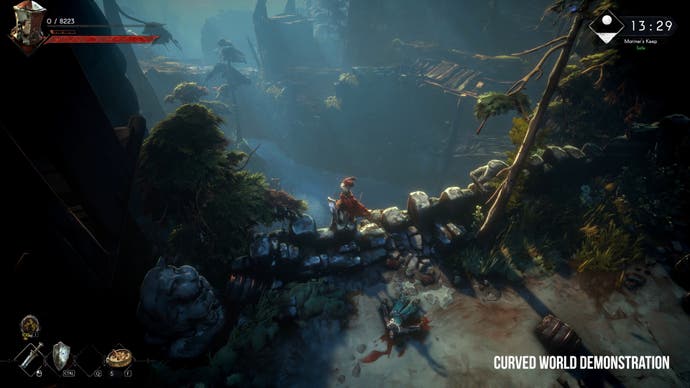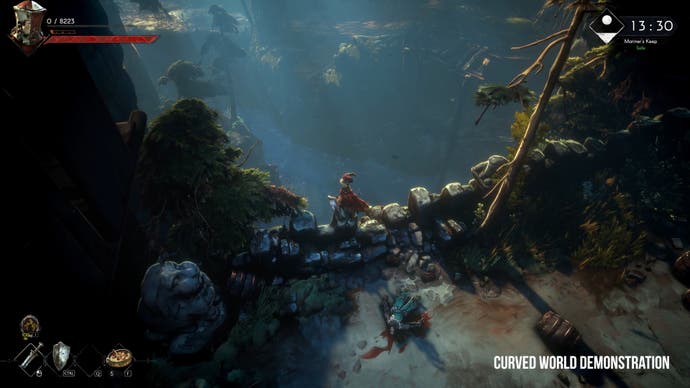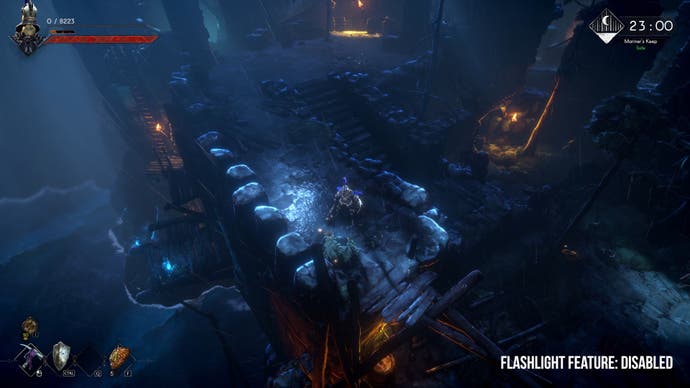No Rest for the Wicked is now available in early access, giving us our first look at Moon Studios' latest project. The developer's previous offering, Ori and the Blind Forest and Ori and The Will of the Wisps, put a spin on the Metroidvania style of gameplay, offering a powerful and fresh experience that's hard to forget. And now, four years later, Moon looks set to do the same for action RPGs with No Rest for the Wicked. Simply put, No Rest for the Wicked combines stunning visual design with elements inspired by titles from From Software's Souls, Blizzard's Diablo, and even Animal Crossing; and yet the whole is greater than the sum of its parts.
At its core, Wicked is still a game based on the Unity Engine but with a wide range of customizations that transform it into something of its own, hence the nickname: Moonity. However, this is only used for the presentation layer of the game: the graphics you see on the screen. Moon has also created a new simulation engine, built on Exit Games' Quantum Engine, to handle the game's logic, including a fully deterministic 3D physics system for networking, which No Rest for the Wicked will debut at a later date. later.
What makes this setup work well is the split between rendering and simulation: basically, input responsiveness is separate from frame rate, so if you're playing on a low-end platform, like Steam Deck, you'll 30 fps, the game will still look the same. As responsive as a game running at a higher frame rate. The images, however, are striking. First of all, Wicked supports HDR from day one; This is important as we've largely considered Ori and the Will of the Wisps to stand out as one of the best examples of HDR in any game released to date. The HDR implementation is excellent and as intense and engaging as Ori. It makes a huge difference if you use an HDR display.
No Rest for the Wicked is presented from a top-down perspective like many action RPGs, but offers a unique visual identity that elevates the presentation. We've often heard the phrase “it looks like a moving painting” applied to games, but I think this description has never been more apt than here. No Rest for the Wicked truly exhibits a hand-painted look: there are moments that look like pre-drawn 2D backgrounds at first glance… until the camera begins to move revealing its true 3D nature.
However, creating an isometric game comes with serious challenges. For example, how can you convey a sense of scale to the player while maintaining visibility? This is one of the key features Moon's tech team focused on and the path selected is what it calls the “curved world.” Inspired by Animal Crossing, the idea is that the entire 3D map is curved away from the player. By doing so, it is possible to see further into the distance. It required a complete overhaul of aspects such as selection, lighting, geometry processing and more. Additionally, lighting is now completely real-time without any baking; This works in conjunction with the dynamic weather and lighting system to ensure the world is constantly changing around you.
However, one of my favorite features is what Moon calls the “flashlight” system: look closely at your character and you'll see a soft light following them. This is nothing new, obviously, but what's important is how it influences the paths and shadows around the player: you can see how the light around the player creates deep shadows that spill around you as you explore. From a visual perspective, it's a cool feature, but what surprised me is how it's used to draw the player's attention to specific parts of a scene.
Manage cookie settings
Another key feature to creating a strong atmosphere lies in the animation of objects in the world, specifically things like trees and fabrics. The weather is a key part: the first area of the game takes place during a storm with a huge volume of GPU-accelerated rain particles floating around. It's entertaining to see what happens if you increase the volume of particles beyond realistic limits; It looks ridiculous, but it's still effective. The detail is notable: as the characters fight in the rain, bursts of water can be seen emanating from their clothes as they animate. It really gives the impression that his clothes have been soaked and the intensity of his movement forcefully throws away the accumulated water droplets.
This relates directly to the unified wind system that influences the fabric and trees around you. It is fully adjustable and dynamic, changing depending on the time of day and weather patterns. It looks especially great around cloth objects, including outfits worn by characters. Speaking of physical interactions, Moon has also included physics simulation for small objects, like rocks, pebbles, and branches that react to your character as you move around the world. These small details are also influenced by events such as explosions. Then there is fluid simulation: it applies to things like water, smoke, fog and the like. You can see it here in this scene when the character goes through the smoke. Beautiful.
The point is that the sheer amount of movement on display makes the world come to life in a way that I found very impressive. It feels just as animated as Ori's 2D games, but manages to do all of this in full 3D on a larger scale while being significantly more interactive. What's interesting is that, with Wicked in Early Access, the team is still working on additional effects that aren't currently in the game. For example, Moon is experimenting with real dynamic water currents. There is also a dynamic mud system developing where moving through thick mud displaces the terrain as you pass through it. Hopefully these will find their way into the game as development progresses.


Actually, this is just a sample of the images. There's a lot to discuss, from the painterly texture work, the edge lighting that seamlessly integrates the characters into the world, and all the other tricks and techniques. Is awesome.
Moving on, if you're interested in trying out the game from day one, you're probably also wondering about options and performance. You see, while No Rest for the Wicked is planned to release on consoles in the future, the current Early Access version is available exclusively on PC right now. The options menu is incomplete at the moment: there are minimal visual detail settings to adjust while DLSS is in process but it is not currently available. The game provides aspects including a resolution slider, dynamic resolution scaling, and HDR support. I especially enjoyed the way the menu disappears as you modify certain settings, allowing you to more visibly appreciate the changes made by your choices in real time. Crucially, this works with the resolution slider, for example.
Performance-wise, it's still early days, but the impression so far is that Wicked is significantly heavier than the Ori games and there's still work to be done. I tested it on my main PC with a Core i9 12900k and RTX 4090, but I also tested it on an older Core i9 9900k system with an RTX 2060 Super, a Core i7 12800H laptop with a 3080 Ti laptop GPU, and even Steam Deck. .


What I found interesting is that all the lower-end systems performed quite well, offering a mostly stable 60 frames per second experience, I would say. It is in line with expectations and requirements. It's certainly not perfect as there are heavy areas where it sags, but it's okay. The Steam Deck is currently being worked on – Moon captured some footage for me and it's clear the performance isn't quite there. It's playable but of course there's work to do here.
The problem is that my main PC didn't do as well as I'd expect. GPU utilization was normal and fine, but the game simulation was seriously locking up on my CPU, resulting in suboptimal frame times that dropped the frame rate below 60 fps in areas near the limits of the cities. I also had problems with stuttering from time to time. This is something the team is trying to resolve right now, as other users may encounter similar issues. In terms of performance, this is definitely the area where its Early Access status is evident. Of course, when you look at PC releases from the last few years, it's probably still in better shape than many non-Early Access games. Given Moon's track record, I expect him to improve significantly as development continues.
Beyond the technology, I also wanted to share some thoughts on the game design. No Rest for the Wicked definitely shares elements with Souls-style games. The animation priority, dodging, blocking, and overall level of challenge feel relatively familiar, but there are some big changes that result in something that feels unique for the genre. First of all, enemy respawn is handled differently: they don't respawn based on your death. Rather, it seems to occur as a function of time. Secondly, health items do not replenish, they need to be found or crafted, and you do not lose experience either. Additionally, Wicked features a proper town to explore with plenty of NPCs to talk to; Honestly, Sacrament is a gigantic multi-level city, something you don't normally see in Souls-type games.
That's how I feel about No Rest for the Wicked so far, but I must emphasize that I'm really just scratching the surface. The game in its current state looks sublime and is extremely promising, but keep in mind that it is in early access, so don't expect a complete, fully polished game, but it will certainly be fun to see the user reaction and how that feedback is. integrated into the game. It will also give players a chance to witness the development process in action – a chance to see No Rest for the Wicked evolve into its final form. Either way, although it's still in development, it's exciting to have a new game from Moon Studios available and rest assured that Digital Foundry will continue to follow it throughout its development.









